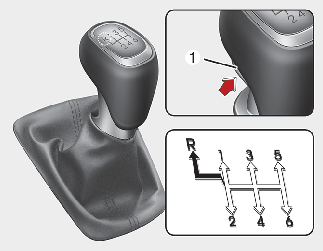Manual Transmission operation

 The shift lever can be moved without pushing the button (1).
The shift lever can be moved without pushing the button (1).
 The button (1) should be pressed when moving the shift lever into R (Reverse).
The button (1) should be pressed when moving the shift lever into R (Reverse).
The Manual Transmission has 6 forward gears.
This shift pattern is imprinted on the shift knob. The transmission is fully synchronized in all forward gears so shifting to either a higher or a lower gear is easily accomplished.
Depress the clutch pedal fully while shifting, then release it slowly.
If your vehicle is equipped with an ignition lock switch, the engine will not without depressing the clutch pedal (If equipped).
The shift lever must be returned to the N (Neutral) position before shifting into R (Reverse).
Push the button located immediately below the shift knob and pull the gearshift lever to the left sufficiently, and then shift into R (Reverse) gear position.
Make sure the vehicle is completely stopped before shifting into R (Reverse).
Never operate the engine with the tachometer (rpm) in the red zone.

-
When downshifting from fifth to fourth gear, caution should be taken not to inadvertently press the shift lever sideways in such a manner that the second gear is engaged. Such a drastic downshift may cause the engine speed to increase to the point that the tachometer will enter the red zone. Such over-revving of the engine and transmission may cause engine damage.
-
Do not downshift more than 2 gears or downshift the gear when the engine is running at high speed (5,000 RPM or higher). Such downshifting may damage the engine, clutch and transmission.
-
In cold weather, shifting may be difficult until the transmission lubricant is warmed up. This is normal and not harmful to the transmission.
-
If you come to a complete stop and it's hard to shift into 1st or R (Reverse), leave the shift lever at N (Neutral) position and release the clutch. Depress the clutch pedal, and then shift into 1st or R (Reverse) gear position.

-
To avoid premature clutch wear and damage, do not drive with your foot resting on the clutch pedal. Don’t use the clutch to hold the vehicle stopped on an uphill grade, while waiting for a traffic light, etc.
-
Do not use the shift lever as a handrest during driving. This can result in premature wear of the transmission shift forks.
-
To prevent possible damage to the clutch system, do not start in 2nd gear except if starting on a slippery road.
-
Do not overload the vehicle. Driving with the vehicle overloaded could cause abnormal friction heat to the clutch disc and damage the clutch cover and disc.

-
Before exiting the car, always set the parking brake fully and shut the engine off. Make sure the transmission is shifted into 1st gear when the vehicle is parked on a level or uphill grade, or shifted into R (Reverse) on a downhill grade. Unexpected and sudden vehicle movement can occur if these precautions are not followed.
-
Do not shift from a high gear to lower gear rapidly on slippery roads.
The vehicle may slip causing an accident.
Using the clutch
The clutch should be depressed fully before shifting, then released slowly. The clutch pedal should always be fully released while driving. Do not rest your foot on the clutch pedal while driving. This can cause unnecessary wear. Do not partially engage the clutch to hold the vehicle on an incline. This causes unnecessary wear. Use the foot brake or parking brake. Do not operate the clutch pedal rapidly and repeatedly.

When operating the clutch pedal, depress the clutch pedal down fully. If you don’t, the clutch may be damaged or noise may occur.

Using the clutch
Depress the clutch pedal as far as possible. Be aware not to apply the pedal again before it returns to the normal position. If the pedal is repeatedly depressed before returning to its normal position, the clutch system might be damaged. Do not overload the vehicle.Starting or driving a vehicle in this situation generates frictional heat to the clutch disc which might cause damage to the clutch cover and disc. When starting the vehicle or driving in R (Reverse), releasing the clutch pedal too soon after shifting the lever might turn off the engine and lead to an accident.
Downshifting
When you must slowdown in heavy traffic or while driving up steep hills, downshift before the engine starts to labor. Downshifting reduces the chance of stalling and gives better acceleration when you need to increase your speed. When the vehicle is traveling down steep hills, downshifting helps maintain safe speed and prolongs brake life.